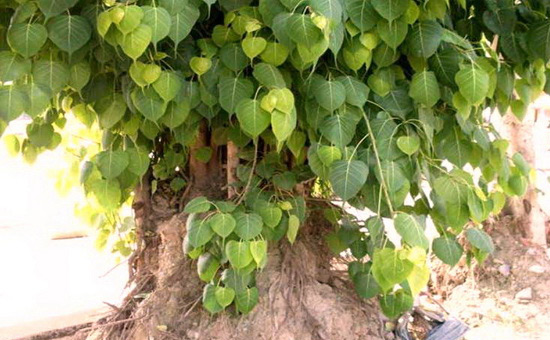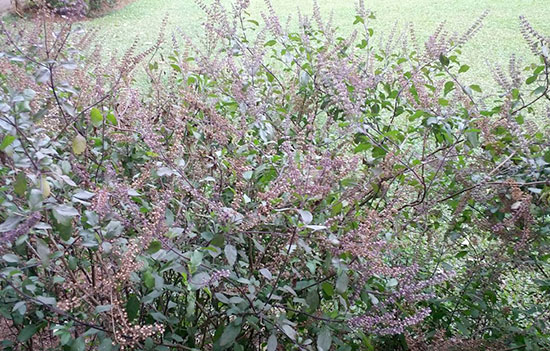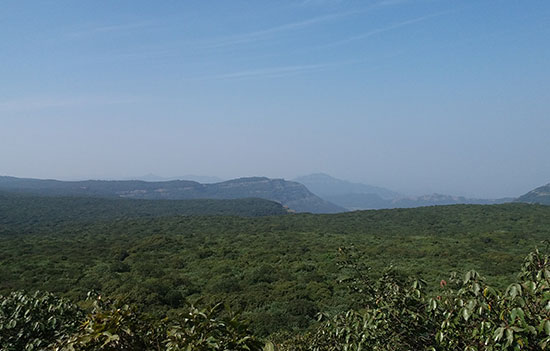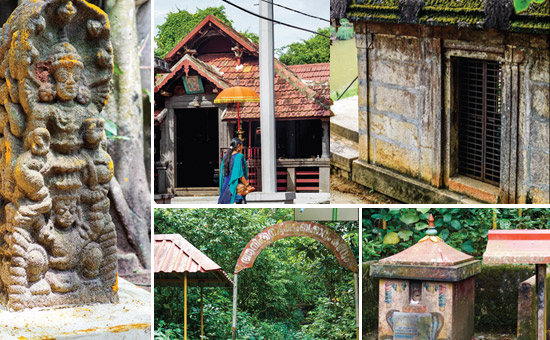- Know about what Indian scriptures say on protection of Plants and Trees
And importance of Forests in Indian tradition, they being the river source and
supportive of wildlife. Conservation of trees and forests is badly needed
today.
“I think that I shall never see, a poem lovely as a
tree,” said the American poet, Joyce Kilmer. Before him, the 17th
century saint poet, of Maharashtra, Sant Tukaram echoed this sentiment with
these words, “Trees and creepers are our friends in the forest.”
Even
the most insensitive and materialistic person will derive feelings of joy whilst
looking at a lush tree, whether decked with bright flowers, laden with juicy
fruit or adorned with delicate new spring foliage or sprinkling brown autumn
leaves.
Trees
are the most conspicuous
manifestation of Mother Nature that showers us with innumerable tangible and
intangible blessings or to put it in scientific terms – provides ecosystem
services! Apart from providing clean
air, water, food and medicines, forests are a great source of aesthetic beauty,
give peace of mind and spiritual bliss.
In an era where unsustainable economic policies have resulted in climate
change, shrinking forests, vanishing biodiversity, depleting groundwater,
chemical loaded food, lifestyle diseases and pandemics, trees are often looked
at as a benchmark of a green way of life.
In this scenario, what if people start protecting trees and nature out
of love, gratitude and respect? Let us explore Indian traditions from this
aspect.
Modern
science + Ancient wisdom = Nature conservation
Technology
and science have enabled a comfortable life; but also been misused. Now science
is helping humans understand the importance of sustainable living. From the
study of ecological importance of mangroves and seasonal vegetation on coastal
plateaus in western India by Bombay Natural History Society (BNHS) to the study
of orchids and rhododendrons in north-eastern states by Botanical Survey of
India (BSI), empirical
evidence is increasingly highlighting the need for conservation of natural
habitats.
It
is interesting to note that our ancestors were sensitive towards nature and knew
the merits of living in harmony with it. In India, the nature
worshipping Vedic culture has always advocated a holistic way of life.
Described as Dharmic living, it encompasses the entire spectrum of sustainability
including lifestyles that are in tune with the eternal cosmic principles,
natural phenomena and the laws of the land, plus being in harmony with all
living and non-living entities. The word Dharma is derived from the Sanskrit root
verb Dhru, which means ‘that which
sustains’ (धारयति इति धर्म)!
This eternal wisdom has, over the
millennia, manifested in Indian traditions in myriad ways. It has made us
revere the sun and rain/plants and animals, preserve sacred groves and pay
obeisance to mountains. The philosophy has percolated into the country’s thoughts
and literature.
In the context of plants, the world’s earliest known
spiritual tome, Rig Veda - Mandal 10,
Sukt 97 says, “Plants, by this name I
speak to you, Mothers, to you the Goddesses.” Later, Varah Puraan says, “As
long as there are mountains, forests and lakes on Earth, humans will live
happily for generations.” In
mediaeval times Sant Dnyaneshwar said, “May all livings beings live in
harmony with each other.” Sant Kabir said, “God is the tree in the forest.”
In fact, not just forests, but all manifestations
of nature are revered in Vedic culture based on the understanding that the same
eternal energy (Atma) dwells in all aspects of creation, thus connecting
everything to the supreme divine source (Paramatma).
While laws do help in protecting nature, they have limitations. Instead,
imagine people conserving forests voluntarily. This is where the tradition of reverence
towards nature comes in. When something is considered sacred, most people
refrain from destroying it even though all may not know deeper significance. A
science student may question the existence of divinity in nature; but will like
to explore the underlying principle behind traditions, esp. when it stems out
of reason.
Let
us rediscover some of India’s practices to know how they can ensure judicious
resource utilization and habitat conservation.
Holy plants and their
protection
Most plants, with tremendous ecological and medicinal value, have been symbolically
depicted in Indian culture to drive home their utility. Linking science and
tradition resulted in conservation of such plants, their habitats and animals
dependent on them. Plants have thus been venerated in this spirit of
coexistence.
For instance, in the southern Konkan region of Maharashtra and Karnataka,
Sacred Fig and Cluster Fig are worshipped as Mahapurush (patron deity) and so are mangrove swamps. No wonder
these gentle giants are the refuge of numerous species of bats, owls, owlets,
barbets, civets, squirrels and monkeys, to name a few. Similarly, in northern
Konkan and Gujarat, forest trees are worshipped as Vruksh Devta by the forest dwelling people.
Mangroves that grow in the marshy tidal areas are the natural buffers
between land and sea that prevent coastal erosion from the action of waves. In
rural areas of Konkan, mangroves still exist in large swathes as a result of
the traditional practices and eco-friendly lifestyles. On the contrary,
mangroves in regions around Mumbai, which is also located in Konkan, have
greatly suffered due to unplanned development and urbanization.
Let us now read about the Sacred Trees in India.
.jpg)
Banyan: This magnificent
tree is a hallmark of the Indian countryside. It provides shelter and food to
birds and animals, and a resting place for travelers. The English name Banyan
is derived from the Indian word Bania
because traders assembled beneath it for transacting business. Its sprawling canopy
of broad leaves resting is effective in pollution control and carbon
sequestration. A hoary specimen often looks like a mini forest in itself. No
wonder, this long-lived tree is respected at the time of Vat Pournima celebrated in northern and western India and otherwise
conserved for its social, medicinal and spiritual significance.

Sacred Fig or Peepal: The extensive canopy of
ubiquitous long-lived native tree plays a vital role in pollution control and is
the habitat for birds and animals in tropical climatic zones.
It has several uses in Ayurvedic medicine. It can uptake carbon dioxide
even at night through CAM Photosynthesis as mentioned in a paper published in
Research Journal of Pharmacy & Technology. Naturally, this chosen tree of
Krishna often has a small shrine under it.
Cluster Fig or Udumbar: The figs of this
tree are the favourite food of many species of birds and mammals, including
Spotted Deer, Jackal and Sloth Bear. Udumbar is known for its myriad uses in
Ayurvedic medicine.
Surapal’s Vrikshayurveda (Ayurveda
for trees) explains the relation between the location of Cluster Fig and
presence of groundwater in the vicinity. Thus, it is considered sacred and
mentioned in Atharva Veda as provider of prosperity.
Indian Lilac or Neem: The common
tree of India’s drier areas is best known for its significant role in Ayurvedic
medicine and as an eco-friendly pesticide.
A paper published in Legume Research indicates the benefits of foliar
application of Neem leaf extracts for better crop yield. It is a favourite tree
in afforestation campaigns. Realizing its immense utility it is traditionally used
in certain chutney preparations and tied in festive ribbons put up on doors.
Mango: This evergreen tree is a great source of food and shelter for many
species of birds and mammals. It also provides nutrition to humans. The
ecological importance of Mango mentioned in Bhavishya
Puraan has been documented in a research paper (2015) in Asian Agri-History
Journal. No ceremony in India is complete without Mango leaves used in ribbons
put up on doors and on the Kalash
full of water.

Holy Basil or Tulsi: No home in
India is complete without a potted Tulsi plant. It is documented in Ayurveda
for its multiple uses as a medicine and germicide. A yellow oil secreted by
Holy Basil is known to have such properties as documented in a research paper (2007)
published in Indian Journal of Experimental Biology.
Many Indian traditions revere various plants that play a key role in
ecology and medicine. The 21 plants worshipped
during Ganeshostav, including Brahmi, Durva, Shami, Rui, Arjun, Kevda,
Jaai, etc. are a case in point.
Important forests revered
and conserved
India, the land of tropical forests since millennia, was able to retain
most of them until the advent of British. The inherently holistic way of life
and symbolic divine depiction of natural habitats in popular culture had resulted
in their conservation and of the wildlife sheltered therein.
Here is a quick tour of culturally protected areas, from a science
perspective.
 Evergreen forests of Mahableshwar, Maharashtra. Pic by author.
Evergreen forests of Mahableshwar, Maharashtra. Pic by author.
Catchment area forests: Across India one comes across mountain forests, which
are the source of rivers, protected as sacred sites. Many of these locations in
the Himalaya, Sahyadri and other ranges have been venerated as the abode of the
divine. For instance, tropical evergreen and semi-evergreen forests adorn many
sacred places in Sahyadri in Maharashtra, which are also the origins of rivers
like Bhimashankar (Bhima River), Mahabaleshwar (Krishna, Koyna, Venna, Savitri
and Gayatri rivers) and Amboli (Hiranyakeshi River).
The presence of significant mammal species such as Tiger, Leopard, Gaur,
Sloth Bear, Wild Dog, Sambar and Giant Squirrel in the forests surrounding the
latter two locations is a proof of their ecological importance, which was well
understood by our forefathers. In fact, many areas to the south and north of
Amboli, now also have resident Elephant herds.
Aranyani Sukt in the 10th Mandal of Rig Veda emphasizes the conservation
of such habitats. If not for these mountain forests, large swathes of land
downstream run the risk of flooding and siltation due to soil erosion. The
heavy rains in these forest clad mountains also support the rich agriculture in
western Maharashtra and parts of Karnataka.
 Sacred Kavu groves of Kerala.
Sacred Kavu groves of Kerala.
Sacred groves: Throughout
the country, many tracts of ancient forests have been protected by the locals
out of faith in the existence of patron deities (energies) that guard the
surrounding region.
Called by different names such as Devrai
or Matavan, these forests invariably
have a small shrine dedicated to the guardian deity. In the past, people have
refrained even from plucking a leaf or a blade of grass from such forests. Sacred
groves protect diverse ecosystems including mountain forests, lowland
forests and wetlands. There are many instances where entire mountain sides have
been denuded due to the greed of modern man.
Interestingly, many wildlife sanctuaries also have sacred groves within
or on the periphery such as at Ahupe near Bhimashankar Sanctuary and Supegaon
near Phansad Sanctuary in Maharashtra. It is time to once again educate people
that the same logic, which advocates protection of sacred groves, had always
encouraged protection of the remaining forests, a fact that was well understood
by the previous generations. Field research (2008) published in International
Journal of Ecology & Environmental Sciences highlights the crucial role
played by the concept of sacred groves in safeguarding that ecosystem.
The moral of the story is that conservation of trees
and forests is the need of the hour. It is
high time that 21st century humans realize its urgency, whether by
studying modern ecological journals or understanding ancient practices. Without
that all talk about environment would be lip service.
Author Atul has 18 years’ experience in the sectors of journalism, PR and environment
education, and currently works as a freelance writer, communicator and
educator. Environment conservation,
sustainable development and application of Indic traditions in the contemporary
context are his areas of interest.
Also read
1. Sacred
Kavu groves of Kerala
2. Banyan
Tree is the National Tree of India
3. Neem
Tree is a remedy for many ailments
4. The
Peepal Tree
5. Tulsi
Vivaha